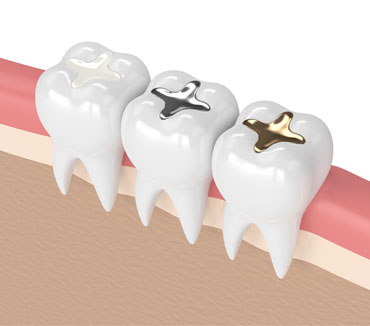The Different Types of Dental Fillings
What is a dental filling?
Were you just told by your dentist that you need a dental filling? Most of us can relate. Many individuals have had to experience the common procedure of having a cavity filled. A dental filling is used to treat a tooth that has become damaged by bacterial tooth decay or fractured as a result of trauma. This treatment helps repair your tooth so that it can properly function, maintain its original shape, and prevent further damage from occurring. Once you have a filling, it must be maintained with good oral hygiene like the rest of your teeth.
What are the different types of dental fillings?

There are many different types of dental fillings, and your dental professional will help you choose the right type for your specific needs. Many factors will be taken into consideration when choosing the filling material, including the location of the tooth needing to be repaired, the extent of the damage, any allergies to the filling materials, and pricing. In addition, if the tooth decay or fracture is extensive, a dental crown may even be recommended. Common filling materials include gold, porcelain, tooth-colored composites, and silver amalgam.
What are the steps involved in the dental filling?
The process of getting a dental filling can be relatively simple. Depending on the location and size of the filling needed, you may be given local anesthesia to numb the site. Then, using dental instruments the surface of your tooth will be prepared for the filling, removing any decay or weak, sharp and unsupported dental enamel that is present. A cavity medication known as a base or a liner may be added to the inside of your tooth if the cavity is in close proximity to the innermost layer of the tooth, known as the dental pulp. If a tooth-colored composite filling is used, an etching and bonding material is often used prior to placing the filling material. Plus, once the filling is placed a special light will be used to harden the filling. Lastly, your filling will be polished and smoothed for a shiny finish. Your bite will be checked to ensure that everything feels back to normal.
It is common to experience some tooth sensitivity after having a filling procedure performed, however, symptoms tend not to last over 2 weeks. If you are experiencing severe or prolonged symptoms contact your dental professionals right away.
What types of filling materials are available?
Cast gold
Cast gold fillings have been praised for their strength, lasting over 15 years in many cases. However, they tend to be one of the most expensive filling materials and may require multiple visits to place.
Silver Fillings (Amalgams)
Amalgam silver fillings are also noted for their strength and resistance to wear. In addition, they are relatively inexpensive. However, due to their silver color they are less esthetic particularly in visible areas of the mouth towards the front. Despite the reported controversy regarding amalgam containing mercury, the American Dental Association, U.S. Centers for Disease Control and Prevention, and World Health Organization all maintain that according evidence-based research, dental amalgam fillings are safe and effective.
Tooth-colored Composites
Composite fillings are highly regarded for their natural appearance to teeth. They tend to be more expensive and may not last as long as other dental fillings. These fillings can also stain similarly to natural teeth depending on specific foods, beverages, and habits like smoking.
Other Filling Types
Other fillings include porcelain fillings, also referred to as dental inlays or onlays. Porcelain fillings are designed to match your natural tooth color and are more resistant to staining than regular composite fillings. Yet like cast gold fillings, they are fabricated in a lab and can be relatively expensive.
Composite fillings are widely used today to repair teeth, because they are more aesthetically suited for use in front teeth and the more visible areas. Not all dental offices offer every type of filling. Most of our Gentle Dental locations use composite fillings.
How much does it cost for a dental filling?
The cost of dental fillings may vary depending on the size of the filling needed, the location of the tooth needing the filling, the type of filling material, and for the accompanying procedures necessary for diagnosis and treatment of the cavity such as examinations, X-rays, and other materials used. Without dental insurance, silver amalgam fillings tend to cost on average around $150. Tooth-colored composite fillings are often more expensive, with an average cost over $200.
Will dental insurance cover the dental fillings?
Many dental insurances include full or partial coverage of dental fillings in their plans. However, this can also depend on many factors specific to each individual’s dental insurance.



